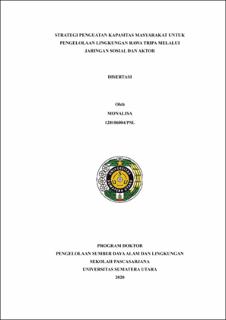Strategi Penguatan Kapasitas Masyarakat untuk Pengelolaan Lingkungan Rawa Tripa melalui Jaringan Sosial dan Aktor
Community Capacity Building Strategy for Managing The Tripa Swamp Environment through Social Networks and Actors

Date
2020Author
Monalisa, Monalisa
Advisor(s)
Fikarwin
Nasution, Zulkifli
Delvian
Metadata
Show full item recordAbstract
Rawa Tripa peatswamp forest is an area of the main peat forest area in Aceh Province besides Rawa Kluet and Rawa Singkil. The Tripa Peat Swamp Forest is part of a peat ecosystem that has an area of around 60,657.29 ha. The Tripa Peat Swamp Forest is also included in the Leuser Ecosystem Area (KEL). This area has experienced environmental degradation due to changes in the allotment area for Other Use Areas (APL), one of which is oil palm plantations. The practices of environmental destruction in Tripa Swamp have caused the quality of the environment to deteriorate so that the living conditions of people become especially communities that depend on natural resource in peat swamp forest Tripa. This dissertation research uses qualitative research methods with the Participatory Action Research (PAR) approach. Structural Theory of Anthony Giddens is used as a tool to explain the model found from the results of Participatory Action Research (PAR) as long as researchers conduct on-site research starting from 2015 - 2018. This model for environmental management in Rawa Tripa is the first step to building community empowerment so that the Rawa Tripa community can manage the natural environment and its surroundings especially for the conservation of the Rawa Tripa peat ecosystem in a sustainable manner. On the other hand, the economic aspects of the residents were also developed to increase the motivation of citizens in terms of preserving natural resources (SDA) Tripa Swamp. Based on the results of this dissertation study, the community capacity building strategy for managing the Tripa Peat Swamp environment through social Networks and Actors was found from several main variables, namely: 1) The Role of the Community in Environmental Management, 2) Social Cohesion and Trust (Trust) and 3) Stakeholder Roles. The derivative variables are; 1) Social Situation, 2) Opportunities for non palm-oil commodities, 3) citizen motivation, 4) conflict management, 5) policies (related regulations), 6) innovation. The effectiveness of the elements (variables) that exist in this study must be continually improved towards a better one so that the goal of communities capacity building can be achieved.
